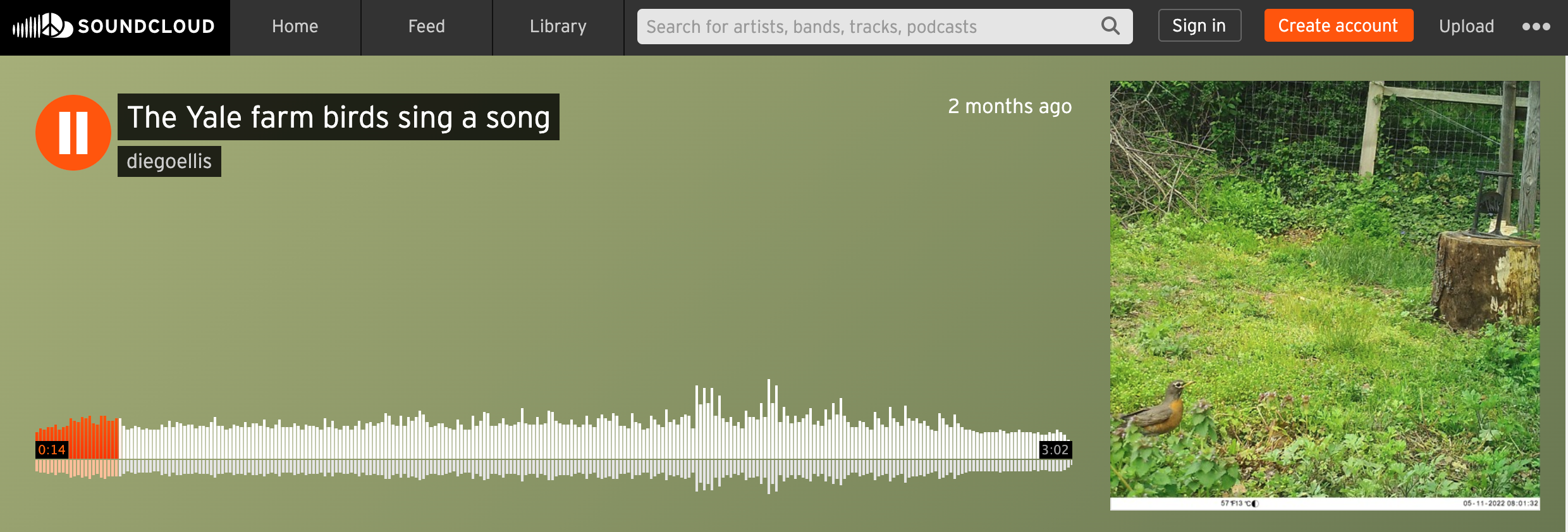This post is part of Diego Ellis Soto’s 2022 Global Food Fellowship.
Birds are chirping, be in the present, I tell myself as I make my way up the familiar hill on Edwards Street. Cars roar up the street containing a mixture of old and new scientific buildings to study physics and chemistry; supercomputing and environmental science are to my left.
Thousands of computers are humming, calculating anything from creating new chemical molecules, to exploring new planets in far galaxies, to identifying areas where hummingbirds will migrate under climate change.
Speaking of migration. Sweaty, but happy, arriving to a 1-acre urban farm that is about to create a song to the buzz of bees, birds, humans, and whoever decides to join and jam along !
Microphone check, says the chicken. The chalkboard next to the Farm’s pizza oven says ‘welcome to the Farm’ in purple colors. Purple like the soundwave of bird calls of what’s there to come; purple like tulips beginning to blossom in the most beautiful of shapes, purple like a red onion about to be chopped for a knead 2 know event. Smile; your shoulders get less tense and let go. Truly, it’s okay. Let go.
Not just the weight of a backpack full of research gear; also, from thinking about the myriad of different things related to other different things, in complicated ways to connect and measure these different things; each somehow related to understanding the natural world.
Be the present.
Working with the land, with bare hands, after hours of meeting someone, on a screen, developing algorithms, on a screen, applying for funding, on a screen. Let the screen go, listen to what birds are chirping, which insects are crawling, frogs are burping, or humans are laughing. We may get some warm cider at the end of the workday if we are lucky or a warm slice of pizza with veggies harvested today.
Today we’ll hear an animal opera. Yes, an opera! Really. Produced and directed locally, by the Farm. We have a chicken on the high hat, howling barred owls looking for small mice around the tomato plants under the protection of a windbreaker, and migratory white and black warbler as an ephemeral vocalist while they replenish themselves of whatever the Farm has in stock. Some bird actors – like the Blue Jay with his clear blue suit – proudly sing dozens of times a day year round; a shy small migratory warbler only sings for the lucky ear a few days a year.
The soil is still a tad cold, it was a cold winter and spring time is reminding us of the change of time, life is waking up in New England. Yet below it all, plants are talking with each other, through the real plant life social network of their roots.
Soon birds will start, one after the other, billion by billion, to fly south – on a voyage across hundreds of miles to Central and South America. We can peek into a snapshot of their life thanks to a small computer and a $9.99 microphone ! (Figure 1)
Figure 1: Setting up the bird spy microphones on a sunny day at the Yale Farm, in Edwards Street, New Haven. This allowed us to listen to and identify birds during the annual spring migration season.
A Black box fancy computer algorithm detects which bird species is singing at all times using ‘deep learning’, while outside, students are learning about organic farming, the logistics connecting farm to table, and baking a great pizza in the wood-fired brick oven.
Next to the compost, tied to a white Maple tree, is a game camera which takes pictures of gophers, squirrels, and other furry or winged musicians – critters of the animal orchestra at Edwards street. To the headache of the farm manager, the gophers have been active lately (Figure 3).
Figure 2: By installing a camera trap next to the Farm’s compost we were able to obtain various pictures of critters, such as this curious gopher (Figure 3), looking for new ways of causing headache to the farm manager.
Figure 3: A Farm-curious gopher.
Bird microphones, and gopher pictures aside; today’s volunteers weed several beds away. The recent rain makes handling the soil incredibly nourishing as I get to learn about the story of today’s volunteers, their relationship with the soil, the soil of their respective home countries, and their day to day lives at Yale. One of them has taught me new dishes from Sri Lanka, while another one became a dear friend.
When asking farm manager Jeremy Oldfield about the right time to seed carrots and radishes, he gives a great answer with a contagious and warm optimism and wisdom of a farmer. He also gives a bag full of carrot and radish seeds, to be planted at the home garden.
Time passes, seeds are planted, spinach, kale, and corn have germinated and grown. They see the days become longer.
It’s summer, it’s warm, nature is in full swing. Every single second our surroundings are exploding with life and reinventing configurations in which every living organism, including us fancy humans, are a collective pulse of.
Ok, enough philosophy and inner monologues! I leave Friday’s workday at the Farm with a smile on my face, a lower stress level, research gear up and running listening to the main actors of tonight sing. At home, I harvest my greens to make space for carrots and radishes while blue jays orchestrate tonight’s outdoors and a Downy woodpecker decides to add some drum and bass.
Fast forward four weeks and the Farm is looking great!
The garlic is several inches taller and there is a vibrant atmosphere of excitement among workday participants and farm managers. I hear laughter, friendly chatter and the sounds of rakes, shovels and chirping birds. Today we will learn and plant corn, beans, and squash together for symbiotic growing, admiring and learning from indigenous peoples’ planting practices.
We pick up cameras and microphones (Figure 2) and learn that several dozens of bird species have used the Yale Farm during spring migration. Some of these species are vulnerable and in decline due to human driven landscape modification and climate change, highlighting the importance of urban farms for birds across the world!
Figure 4: Hundreds of garlic cloves stretching in sun salutation with their leaves on a sunny day at the Farm.
In fact, in the last 50 years alone we have lost up to 30% of all birds in the United States! At the Farm, we see so many different layers and facets of biodiversity – from bees pollinating a plant whose pathogens are being eaten by bats, to birds foraging on some of the falling apples by the apple tree. It doesn’t hurt when a warm cup of cider, a lecture on sustainability, live music or poetry awaits at the end of the day.
The first building block to halting biodiversity loss requires us to know where species are and where they are not. It is also key to understand the relationship of biodiversity and our working landscapes from which us humans acquire our food. We all come from, end up in, depend on healthy soil, and must share this in a sustainable manner in an ever-crowded planet.
Identifying which species occupy small farms – such as the Yale Farm – helps understand how small-scale farm operations can be stewards of biodiversity while ensuring food production.
Let’s move from farming and science to music! At home, close all browser tabs used for research, put on headphones on. Open the music production software Ableton Live. After scrolling through some bird spy microphone recordings, we add recordings of ‘background noise’ to our opera as background; a good old trick for making Lo-fi beats sounding rawer.
We then add recordings from American Robins, the A.I. of the bird spy microphones has birds nicely labeled by name in each folder separately.
The chirping of birds, the clucking of chickens and the sound of a breeze evoke mellowness and tranquility. The same content felt after a day of working at the Farm. I try to transfer this feeling of tranquility into musical notes by jamming along with my synthesizer. The result is called ‘The Yale Farm Birds sing a song’ and can be found on Soundcloud.
Figure 5: The Yale farm birds sing a song, available on Soundcloud.
But why does farm music matter? Why does this matter for food systems, biodiversity, and us as people?
Perhaps to start by acknowledging that most of the food cultivated on earth is grown by small scale farm owners, which also increases resilience to extreme climatic events and increases food security. The field of agroecology studies how farming can align with ecological processes in a more sustainable way.
A better understanding of what birds live in farms, whether they provide important ecosystem services, or contribute negatively by eating crops, is critical for sustainable planning.
If we zoom out and think about the future, perhaps we can teach about biodiversity through the lens of music; we could motivate a whole new generation of youth to record and document the trends of birds in our neighborhoods, farms, backyards, schools or hospitals. This of bird bachata or cricket LoFi.
Such effort should be embedded into environmental and social justice principles. Lessons learned at the Yale Farm taught by the animal opera, could be applied as educational material for K12 STEM initiatives in New Haven and beyond. Our youth could collect environmental justice-rooted information on our city birds, improving our understanding on biodiversity, while making music and being able to connect with nature in urban environments. Nature is everywhere and offers music to those who listen; or who record it with a bird spy microphone (you can see this recording if you want to find out more)!
Can we apply lessons learned in New Haven somewhere else? Yes, definitely! At larger scales, initiatives such as TUBA (Training Undergraduate Biologists through urban Agriculture) are creating new hands-on curriculum for undergraduates by combining urban farming with biodiversity. This could attract a whole new range of computer science, art and musical students through music making of the natural world!
Figure 6: Panoramic photo of setting up cameras in the NW corner of the Yale Farm, facing the Lazarus Pavilion.
Months pass by again and it is Fall. Every single tree on my way up to Edwards Street has put on their best dress in a color palette with hundreds of shapes of green, yellow, red, and maroon. I am distracted from the beautiful old and new buildings by the red maple trees, which will provide delicious syrup later in the year. This time at the Farm there is no music recording, perhaps weeding, perhaps being, perhaps harvesting, perhaps cleaning.
The birds at the Farm are still chirping. Together they represent an ecosystem, ecosystems playing jazz from Monday to Sunday. This jazz will play long before and after we are gone and go back to the soil, to feed the earthworm that the early bird had for breakfast.
Thank you for listening.







